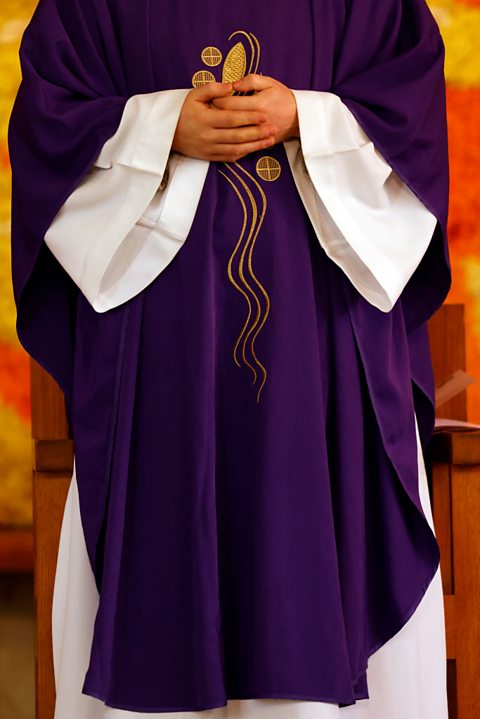
You might have heard people discuss giving something up that they enjoy for Lent, like chocolate or social media, or doing something extra instead, such as additional chores or volunteering.
Lent is the six-week period leading up to Easter. It begins on Ash Wednesday, the day after Shrove Tuesday (widely known as Pancake Day).
Christians across the world will mark Lent by praying, fasting, donating food or money and generally reflecting on their past actions and seeking forgiveness.
If youâre not familiar with the ins and outs of Lent, weâve picked four symbols associated with the period to help explain why and how Christians mark this time of year.

Number 40
Lent lasts for 40 days and nights each year, ending with Holy Week and Easter. This period of time reflects the 40 days that, according to the Gospels, Jesus spent in the wilderness, fasting and asking for repentance whilst being tempted by the devil. Lent is a time for thinking about the suffering Jesus faced, so Christian people might make their own small sacrifice â for example giving up certain foods â to test their self-discipline.
How those 40 days are counted differs depending on whether youâre a member of a Western or Eastern church.
In Western churches, Sundays arenât included within the 40 day total whereas they are counted in the Eastern churches. As a result, the former begins Lent on the seventh Wednesday before Easter Sunday, known as Ash Wednesday. Meanwhile, the Eastern churches start what is known as Great Lent on the Monday of the seventh week before Easter. It finishes on the Friday that falls nine days before Easter Sunday. The date of Easter Sunday is not the same for each group of churches, as they use different calendars to calculate it.

Ashes on the forehead
Ash Wednesday marks the start of Lent and is a day of penitence, meaning that many Christians will spend it praying for forgiveness for their sins and fasting.
If youâve ever spotted someone walking around with a dark marking on their forehead during Ash Wednesday, those are real ashes, applied in the shape of a cross during a religious service. Typically, the ashes are collected from the previous yearâs ââFor Christians, the Sunday before Easter, the first day of Holy Week, when they recall the triumphal entry of Jesus into Jerusalem. palms, which are burnt and then crushed to create the ashes. Sometimes anointing oil will be mixed in as well.
The ashes are symbolic of death and sorrow for sin. As a priest applies the ashes, they will say something along the lines of: âRemember that you are dust and unto dust you shall returnâ. The exact wording varies between different Christian denominations, but the general meaning stays the same. This wording is referring to the belief that it was God who breathed life into humans, and that when we one day die, we will return to the dust from which we came.
The cross shape is itself significant. The most obvious symbolism is of Christâs crucifixion, how his suffering and death on the cross freed humanity from their sins. But it is also a reminder of the mark of the cross made during baptism.
At the end of the service, traditions diverge based on the denomination. Some Christians will leave the mark on their forehead as a way of showing their faith and the message of the ashes to the world, whilst others will remove it to signify that their sins have been washed away.

The colour purple
Throughout the year, many Christian churches will cycle through a series of Related to religious worship. colours which indicate the different liturgical seasons and highlight special occasions. Purple is the colour associated with Lent and it is frequently used on a priestâs clothing as well as the various pieces of cloth that decorate the altar and church.
Historically, purple was associated with high-ranking figures of authority and wealth because the dye was so difficult to produce, making it expensive. The link between purple, royalty and Jesus emerges within the narrative of Good Friday. Prior to Jesusâ crucifixion, the Gospel of John states that he was mocked by a group of Roman soldiers who covered him in a purple robe, thrust a crown of thorns upon his head and beat him, saying âHail, king of the Jews!â.
For Lent then, purple is symbolic of Jesusâ pain and suffering as well as a reminder that believers should seek repentance.

Fish
Fasting plays a significant role throughout Lent, and is often symbolically represented by a fish.
For example, Catholics are obliged to fast on Ash Wednesday and Good Friday as well as avoiding meat on every Friday during Lent. This doesnât include fish, which led to the tradition of eating fish on a Friday. Orthodox Christians are faced with an even stricter fast, as they are encouraged to abstain from meat, fish, dairy products, oil, and wine throughout Lent.
A fish symbol is also sometimes used to represent Christianity as a whole, and is known as the ichthus (the Greek word for fish). Early Christians used the Greek symbols that make up the word to create the acrostic âIesous Christos Theou Yios Soterâ, which translates as âJesus Christ, Godâs Son, Saviour.â
This article was first published in February 2023.
The tricky Easter traditions quiz
Where do they throw water over people on Easter Monday? Or dress as witches? Crack our quiz here.

Why does the date of Easter move around?
There's a reason why it's a moveable feast - find out why here.

Five words to explore Ramadan
Five words that will give you an understanding of what Ramadan means and how itâs marked by Muslim families.
